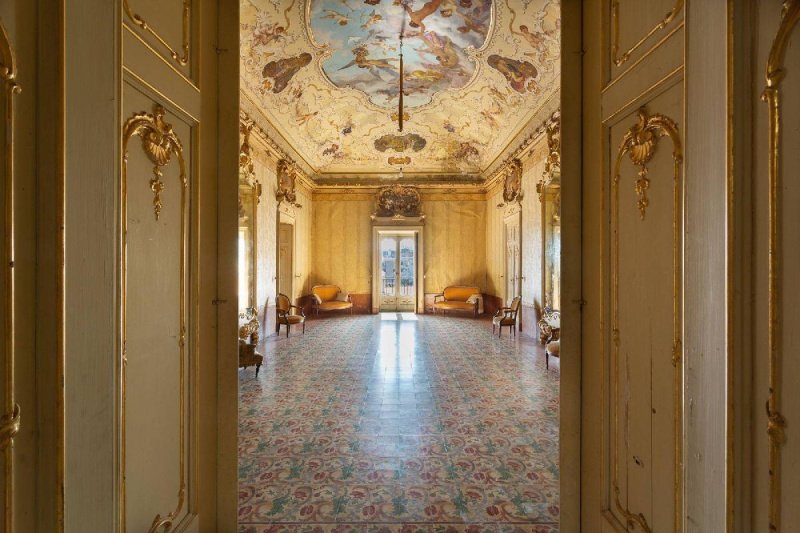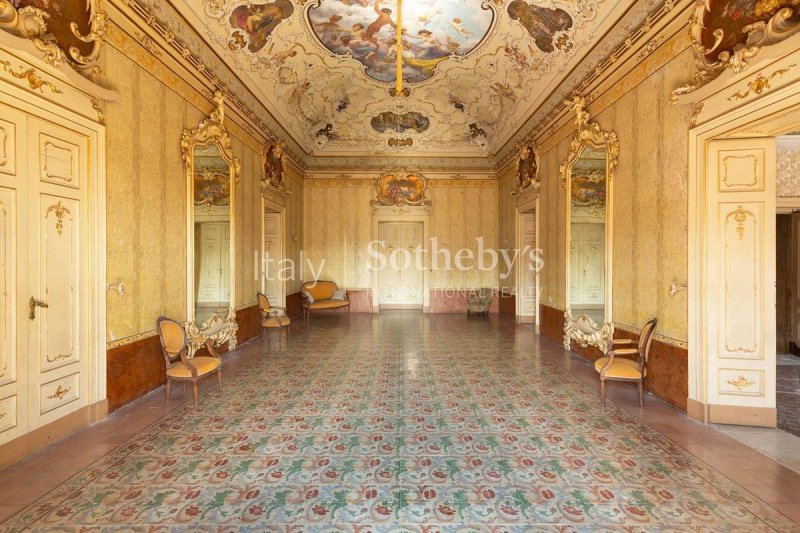The Antico Palazzo Nobiliare is an authentic jewel set in the heart of Palazzolo Acreide and dates back to 1700. Subsequently, in 1900 it was restored and enriched with suggestive decorative elements. The façade has a door and windows framed in limestone and balconies supported by carved shelves. The richness of the decorations, the mirrors and the polychromies of the original cement tiles, now increasingly rare, give the building great charm. An evocative setting that tells the story, the taste and the splendor that remind us of the atmosphere of the past. The building is accessed through a large entrance onto which there is a concierge, the old cart and two warehouses. A wide pitch stone staircase, surmounted by an arch with stuccoes, leads to the first floor. Here we are welcomed by a beautiful and large hall with imposing ancient mirrors. The precious frescoes on the vault were made by the famous Catania painter Alessandro Abate. There are also four lounges overlooking the central hall, one decorated with stuccoes and the other three with vaults painted with frescoes by the painter Scalia. Another internal wooden staircase leads to the mezzanine equipped with a large entrance hall, the closet which is accessed from the kitchen, two bathrooms and an attic consisting of several rooms, one of which is quite large. An interesting element of the Ancient Noble Palace is the large internal garden. Here there is a decorated glass door and mullioned windows. The beautiful garden offers the palace great brightness and air. The ideal place for evenings with friends. The Ancient Noble Palace in the ancient village among the most beautiful in Italy, is located near the church of San Paolo, the ancient Greek theater and the rock sanctuary with the famous Santoni from the mysterious cult of the Magna Mater.
自动翻译所用的语言
L'Antico Palazzo Nobiliare è un autentico gioiello incastonato nel cuore di Palazzolo Acreide e risale al 1700. Successivamente, nel 1900 restaurato e arricchito di suggestivi elementi decorativi. La facciata si presenta con portone e finestre incorniciate in pietra calcarea e balconi sorretti da mensole scolpite. Le ricchezze delle decorazioni, gli specchi e le policromie delle originali cementine, oggi sempre più rare, conferiscono al palazzo grande fascino. Un suggestivo ambiente che racconta la storia, il gusto e la fastosità che ci rimandano nell'atmosfera del tempo passato. All'edificio si accede attraverso un grande ingresso sul quale si aprono una portineria, l'antica carretteria e due magazzini. Un'ampia scala in pietra pece, sormontata da un arco con stucchi, conduce al primo piano. Qui ci accoglie un bellissimo e grande salone con imponenti antichi specchi. I preziosi affreschi della volta furono eseguiti dal famoso pittore catanese Alessandro Abate. Vi sono inoltre quattro salotti con affaccio al salone centrale, uno decorato con stucchi e gli altri tre dotati di volte dipinte con affreschi del pittore Scalia. Un'altra scala interna in legno porta al mezzanino corredato dall'ampio ingresso, il ripostiglio al quale si accede dalla cucina, due bagni e da una mansarda costituita da più vani, uno dei quali abbastanza ampio. Elemento interessante dell'Antico Palazzo Nobiliare è l'ampio giardino interno. Qui si affaccia una porta a vetri decorata e finestre bifore. Il bellissimo giardino offre al palazzo grande luminosità e aria. Il luogo ideale per serate in compagnia di amici. L'Antico Palazzo Nobiliare nell'antico borgo tra i più belli d'italia, si trova vicino la chiesa di San Paolo, l'antico teatro greco e il santuario rupestre con i famosi Santoni dal misterioso culto della Magna Mater.
Der Antico Palazzo Nobiliare ist ein authentisches Juwel im Herzen des Palazzolo Acreide und stammt aus dem Jahr 1700. Anschließend wurde er 1900 restauriert und mit dekorativen Elementen angereichert. Die Fassade hat eine Tür und Fenster aus Kalkstein und Balkone, die von geschnitzten Regalen getragen werden. Der Reichtum der Dekorationen, der Spiegel und der Polychromien der ursprünglichen Zementfliesen, die jetzt immer seltener werden, verleihen dem Gebäude großen Charme. Eine eindrucksvolle Kulisse, die die Geschichte, den Geschmack und die Pracht erzählt, die uns an die Atmosphäre der Vergangenheit erinnern.
Der Zugang zum Gebäude erfolgt über einen großen Eingang, auf den sich ein Concierge, der alte Karren und zwei Lagerhäuser befinden. Eine breite Steintreppe, die von einem Stuckbogen überragt wird, führt in den ersten Stock. Hier werden wir von einer schönen und großen Halle mit imposanten alten Spiegeln begrüßt. Die kostbaren Fresken auf dem Gewölbe wurden vom berühmten Maler Alessandro Abate aus Catani angefertigt. Es gibt auch vier Lounges mit Blick auf die zentrale Halle, eine mit Stuck verziert und die anderen drei mit Gewölben, die vom Maler Scalia mit Fresken bemalt wurden. Eine weitere interne Holztreppe führt zum Zwischengeschoss, das mit einer großen Eingangshalle, einem von der Küche aus zugänglichen Schrank, zwei Badezimmern und einem Dachboden mit mehreren Räumen ausgestattet ist, von denen einer recht groß ist.
Ein interessantes Element des Ancient Noble Palace ist der große Innengarten. Hier gibt es eine dekorierte Glastür und zweiflügelige Fenster. Der schöne Garten bietet dem Palast viel Helligkeit und Luft. Der ideale Ort für Abende mit Freunden.
Der antike Adelspalast im alten Dorf, der zu den schönsten Italiens zählt, befindet sich in der Nähe der Kirche San Paolo, des antiken griechischen Theaters und des Felsenheiligtums mit den berühmten Santoni aus dem mysteriösen Kult der Magna Mater.
Le "Antico Palazzo Nobiliare" est un authentique joyau du XVIIIe siècle, situé au cur du village de Palazzolo Acreide. Par la suite, en 1900, il a été restauré et enrichi d'éléments décoratifs suggestifs. La façade a une porte et des fenêtres encadrées de calcaire et des balcons soutenus par des étagères sculptées. La richesse des décors, les miroirs et les polychromies des carreaux de ciment d'origine, de plus en plus rares, confèrent au bâtiment un grand charme. Un cadre évocateur qui raconte l'histoire, le goût et la splendeur qui nous rappellent l'atmosphère du passé.
L'accès au bâtiment se fait par une grande entrée sur laquelle se trouvent un concierge, l'ancien chariot et deux entrepôts. Un large escalier en pierre, surmonté d'une voûte en stuc, mène au premier étage. Ici, nous sommes accueillis par une belle et grande salle avec d'imposants miroirs anciens. Les précieuses fresques de la voûte ont été réalisées par le célèbre peintre de Catane, Alessandro Abate. Il y a aussi quatre salons donnant sur le hall central, l'un décoré de stucs et les trois autres de voûtes peintes de fresques du peintre Scalia. Un autre escalier intérieur en bois mène à la mezzanine équipée d'un grand hall d'entrée, le placard auquel on accède depuis la cuisine, deux salles de bains et un grenier composé de plusieurs pièces dont une assez grande.
Un élément intéressant de l'ancien palais noble est le grand jardin intérieur. Ici, il y a une porte en verre décorée et des fenêtres à meneaux. Le beau jardin offre au palais beaucoup de luminosité et d'air. L'endroit idéal pour les soirées entre amis.
L'Ancien Palais Noble dans l'ancien village parmi les plus beaux d'Italie, est situé près de l'église de San Paolo, de l'ancien théâtre grec et du sanctuaire rocheux avec le célèbre Santoni du mystérieux culte de la Magna Mater.


